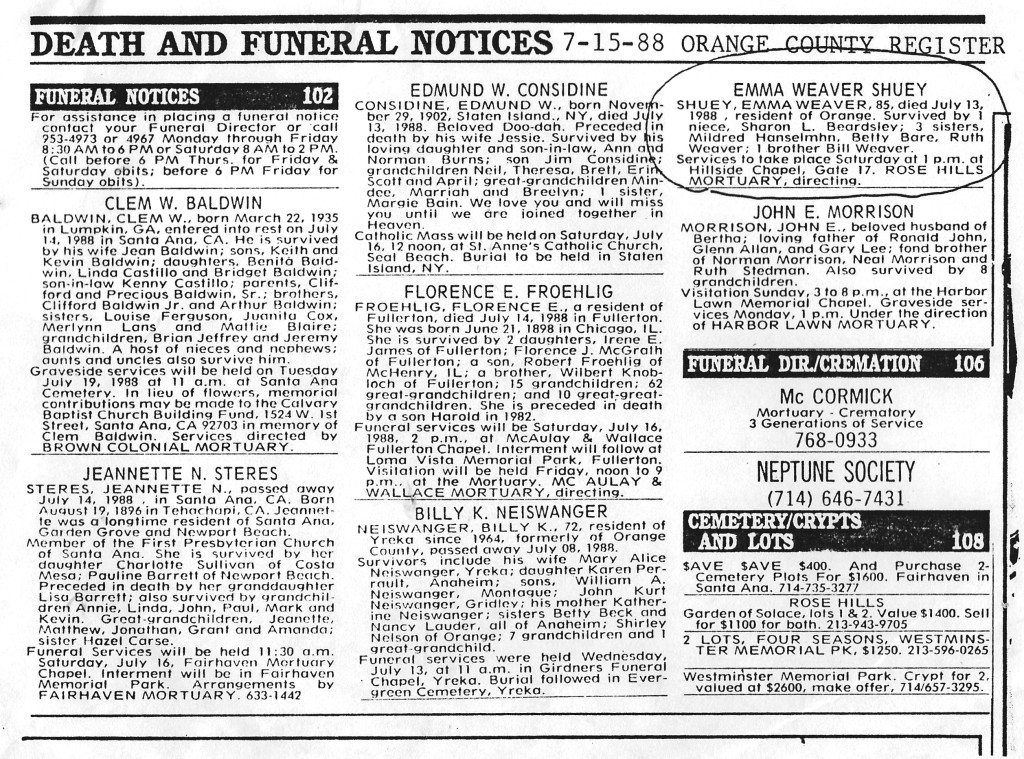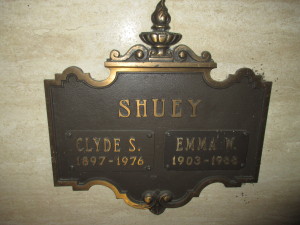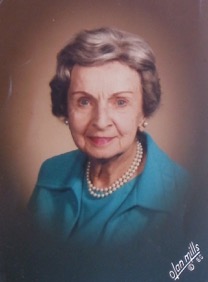
Emma Mae Weaver was born on March 22, 1903 in Churchtown, Pennsylvania, a very small community located in Caernarvon Township in Lancaster County. Her parents were Jacob S. and Annie F. Weaver. There were 10 children in the Weaver household and Emma was the second oldest. Her older sister, Kathryn was born in 1899. So she was 4 years older than Aunt Emma. Kathryn married Isaac Gehman in 1916 at age 17. She, of course, left the Weaver home, leaving Aunt Emma at age 13 the eldest daughter (in fact the only daughter at that time) to help with household chores, including caring for her siblings, which were five at the time. Emma raised her family which was later to include four more daughters. Actually, Grandma Weaver was not very domestic, so responsibility was left to daughter Emma.
The Weavers were an old Pennsylvania family whose ancestry could be traced back to the 1500s in Switzerland. Emma’s parents were initially Mennonites. Many early settlers in the area were Swiss and German Mennonites and several church congregations of various faiths formed there during the 1760s. The village called Churchtown, was a deeply religious community. All the Weaver children attended Churchtown Mennonite Church. But as each one reach the age where they could choose their preferred worship affiliation, most seemed to become members of the Methodist Church in their respective communities. This too reflected Aunt Emma’s influence since she attended the Churchtown Methodist Church.
Education and the fondness for learning was in Emma’s blood. She began her educational career early. Even thought she did not have a teaching credential, she was hired as a teacher in her hometown. It was an Amish community and she taught Amish and Mennonite children, along with her own siblings, in a tiny one-room schoolhouse.
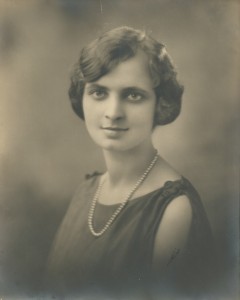
Emma graduated from Millersville State College. Altogether, she taught school for 14 years in Caernarvon Township, then 2 years in Strasburg. In the year 2000, the Strasburg population was 2,800 so you can imagine how small the population was back then when Emma taught there!
Emma Weaver suffered from Raynaud’s Disease, a condition which causes some areas of the body — such as fingers, toes, the tip of the nose and ears — to feel numb and cool in response to cold temperatures or stress. In this disease, smaller arteries that supply blood to the skin narrow, limiting blood circulation to affected areas. For most people, Raynaud’s Disease is more a nuisance than a disability.
California’s warm climate enticed the energetic young Emma to head west. Her doctor confirmed that sunny California would help her with her affliction. For anyone wishing to come up in the world, the Golden State was the place to be! California was always in the news; it was modern and hip, progressive and high tech. It was just like New York, minus the cold.
Emma found herself in Tekamah, Nebraska on the first leg of her journey. Her Aunt Frances (her mother’s sister), lived in Lincoln, Nebraska. Emma taught school for about a year in Tekamah, but the weather was extremely hot and humid during summers, and very cold in winter. In 1938, she packed up her meager belongings and made the final journey to the Golden State.
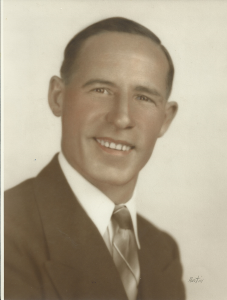
Through hard work and pinching pennies, Emma had saved up enough money to enroll at the University of Santa Barbara. She met a nice young man named Lawrence Delworth, who was from Ohio. They were married on January 1, 1940. Probably due to financial constraints, the Weaver Family could not attend their wedding in California. With the exception of Emma’s younger sister Mildred, who moved to California in 1939, the rest of the family never met Lawrence.
Tragically, the marriage of Emma and Lawrence Delworth would be short lived. There was a flu epidemic and they both wound up in the hospital. On January 3, 1941, just two days after their first wedding anniversary, Lawrence passed away. The doctors did not tell Emma the bad news until she had made sufficient recovery.
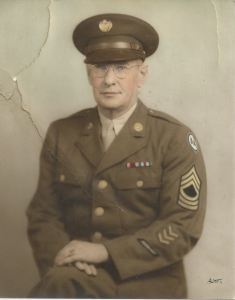
Emma Weaver attended UC Santa Barbara during the war years. It was there that she met her second husband, Clyde Sherill Shuey, a native of Washington state. Clyde went to Europe and served as a master sergeant in the US Army’s Anti-Aircraft Command. When the war ended, they were married on August 15, 1946.
Emma continued her education. She attended the University of Southern California and received her masters. Years of classroom teaching gave Emma a solid background in how students and their parents thought and behaved. Likewise, as an administrator, she worked with the school board to maintain high levels in education. She taught school in Riverside County for four years, then came to Rosemead where she taught 7th grade at Muscatel Jr. High School. In May 1953, the Rosemead School District Board of Trustees selected her to become the first principal of Wells Elementary School.
From the start of the school year in 1953 until the end of school in June 1968, Mrs. Shuey worked tirelessly to give her students the best education possible. She backed and supported her teachers if she thought they were in the right, and disciplined or removed teachers quickly if they did not measure up. She encouraged her teachers to promote healthy competition in the classroom.
In order to encourage responsibility and self-esteem, she instituted a school safety program which allowed 6th graders to become hall monitors. She also allowed a 6th grade student to man the office telephone. When calls came in, the student was instructed to say, “Hello, you have reached Wells School. This is a student speaking…” Then the phone would be handed over to the school secretary. Mrs. Shuey also had 6th graders “work” in the cafeteria, dishing out portions of food onto students’ trays.
The annual May Day Festival was instituted in 1954. This event brought together the local PTA, parents, teachers, and students. This was Mrs. Shuey’s pet project. Everyone looked forward to the pageantry, except for the boys.
By 1968, Mrs. Shuey had devoted more than 45 years to teaching, 15 as principal of Wells School. It was now time to retire. When she was notified by the Board of Trustees that they were going to name the school after her, she was very surprised at the great honor. At the ceremony, standing by the metal plaque affixed to the wall outside of the office, she remarked: “Now remember, it’s the Emma W. Shuey School, not Shuey School!”
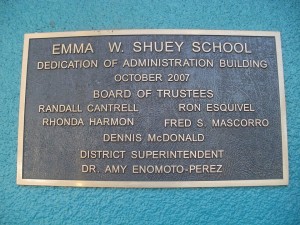
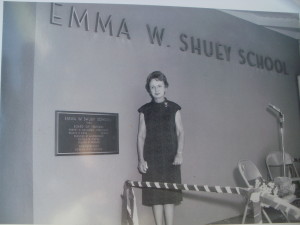
Sharon Beardsley remembers the personal side of her aunt which very few people know today: “When Emma was residing in Churchtown, as the eldest child living and as the oldest sister, she taught her siblings. She took care of her brothers’ and sisters’ children; she gave most of them piano lessons, and a college education. She took care of all the dental costs and braces, paid for their swimming lessons, tennis lessons…she did everything! You have no idea how many nieces and nephews she put through college!”
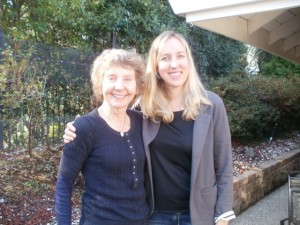
“Emma never had children of her own,” said Sharon. “But she considered all of the family, her brothers’ and sister’s children, to be her children, just like the children at her school. Emma went to church every Sunday because that’s the way it should be and it all came around. She was a Methodist. She put her way through USC; she was blessed. I’m telling you, she was a Mother Theresa, Emily Post, and she was a Pollyana, all those people in one person!”
Suzanne Pritchard, grandniece of Emma Shuey, once interviewed Emma for her 5th grade project. This is a part of her report:
“In her school, there were 35 to 40 kids in the classroom which had grades 1, 2, and 3. Another classroom would have grades 4, 5, and 6. If you had to go the restroom, you had to raise two fingers; if you wanted to drink water, you raised one finger. At her school, there was strict discipline, and if you misbehaved, you would have to stay after school and have no recess, and have extra work. She studied physiology, geography, history, math, reading, English, and spelling. When she was in high school, the grades went from 9th through the 12th grade. Her favorite subjects were math and English.”
“Toys and games she had were dolls, marbles, checkers, and playing the piano, crocheting, and knitting. She had cats, rabbits, and a dog. She liked to read Bible stories, Christian Anderson books, and Christmas stories. When she was a teenager, they like to wear buns and the clothing style were long sleeved dresses down to the ankles. Her first job was being a teacher at $75 per month, and the following year, $100 a month, working 8 hour and 9 months out of the year.”
“At Millersville College, she liked to sing in the choir and play baseball. At home, she took care of four babies and worked in the garden, and once a week, the butcher and baker would go to their house to deliver bread and meat. Houses in Churchtown were made of stone or wood.”
Doug Enck, a nephew of Emma Shuey, adds that “Emma’s mother was not particularly strict. She had a Reformed background, not Mennonite. Aunt Emma’s father was very strict. In fact, many have told me over the years that he was really quite narrow minded. Quite honestly, Aunt Emma did not have much respect for her father. She felt that he was uncaring to the girls in the family, particularly to her younger sister Ruth, who had some learning disabilities.”
“Aunt Emma’s father operated a flour mill alongside their home just outside of Churchtown, which was his father’s before him and his grandfather’s before that,” remembered Enck. “The mill mysteriously burned, and being a Mennonite, Grandfather Weaver (Aunt Emma’s father), had no fire insurance. The family was practically destitute. Grandfather Weaver began to drive a truck for a local businessman. He died in 1932 at the age of 55. Aunt Emma’s grandfather was Bishop Benjamin Weaver, a very progressive thinker and well respected leader within the Mennonite community and the larger community as well.”
The students at Wells School could never know their principal personally. About the only thing they knew about her was that her name was Mrs. Shuey and she was the principal. Many of them today still have no idea who she was!
“She was really a very remarkable woman!” remembered Suzanne Pritchard. “She was my great aunt, but she was like my grandma. She raised my mom and we lived close together in Orange (CA), and we loved to play Canasta card games together. She cared about everybody a lot, a very sincere person, a little bit quiet, but very caring.”
“While teaching in Rosemead, she built this magnificent house in Glendora. She designed it. Incredible! Her second husband was Clyde Shuey, from Washington state, who worked for a title insurance company in downtown LA, and they saved their money. My aunt and Clyde met in Santa Barbara while she was attending school. He did not often show emotion but was extremely proud of his wife Emma. His father and mother owned banks in Washington, and when his mom passed away, his father remarried. Clyde’s new step-mother took all of the money and threw his father out, and so Clyde ended up with nothing.”
Emma Shuey knew how to dress as many people have commented. For work, she dressed like a businesswoman of her era. However, at home, she dressed comfortably and casually.
Emma observed formality and her nephew Doug Enck contributed this personal antidote: “In 1985, I got married. My wife, stepdaughter, and I were going to attend a conference in Phoenix. We decided to spend a few days in California before going to the conference. I wanted Aunt Emma to meet my bride and daughter. At the time, Aunt Emma had moved from Glendora to Orange. We were planning to arrive about 12:00 noon. I misjudged the time it would take for me to get from our previous night’s lodging to Orange. We arrived about 10:30am. I knocked on the door, Aunt Emma answered and the first words out of her were ‘my sakes,’ (a frequent expression), ‘you’re early!’ She had been busily vacuuming and was, of course, in her ‘everyday clothes’. I understood. I told her that we would drive around Orange for a while, and return later. That was fine. We did return at the appointed hour of 12:00 noon. Again we were warmly greeted, but this time Aunt Emma had put on her ‘face,’ was very nicely dressed and after some time of conversation and catching-up she served us lunch. The place settings were correctly placed, a salad and lunch was elegantly served, and everything was very proper and lovely. We really had a great time together. We actually spent a couple of days with her.”
After retirement, Emma moved from Glendora to Orange, CA. Her husband Clyde passed away on July 16, 1976. She continued to be bothered by Raynaud’s Disease. In her later years, Emma found comfort and companionship with her good friend Harry Curtner.
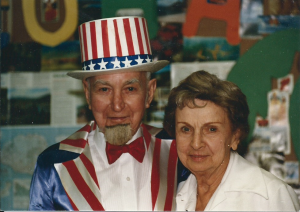
Eventually her health began to decline. She passed away at age 85 on July 13, 1988. Emma Weaver Shuey is interned at Rose Hills Cemetery in Whittier.
